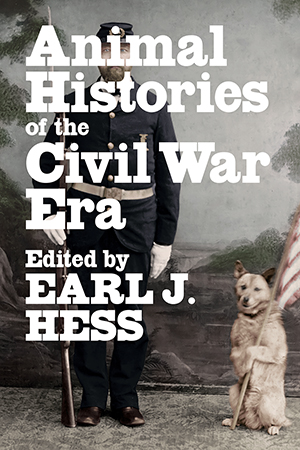
288 pages / 6.00 x 9.00 inches / 10 halftones
History / United States - Civil War Period | History / Essays | Nature / Animals
Animals mattered in the Civil War. Horses and mules powered the Union and Confederate armies, providing mobility for wagons, pulling artillery pieces, and serving as fighting platforms for cavalrymen. Drafted to support the war effort, horses often died or suffered terrible wounds on the battlefield. Raging diseases also swept through army herds and killed tens of thousands of other equines. In addition to weaponized animals such as horses, pets of all kinds accompanied nearly every regiment during the war. Dogs commonly served as unit mascots and were also used in combat against the enemy. Living and fighting in the natural environment, soldiers often encountered a variety of wild animals. They were pestered by many types of insects, marveled at exotic fish while being transported along the coasts, and took shots at alligators in the swamps along the lower Mississippi River basin.
Animal Histories of the Civil War Era charts a path to understanding how the animal world became deeply involved in the most divisive moment in American history. In addition to discussions on the dominant role of horses in the war, one essay describes the use of camels by individuals attempting to spread slavery in the American Southwest in the antebellum period. Another explores how smaller wildlife, including bees and other insects, affected soldiers and were in turn affected by them. One piece focuses on the congressional debate surrounding the creation of a national zoo, while another tells the story of how the famous show horse Beautiful Jim Key and his owner, a former slave, exposed sectional and racial fault lines after the war. Other topics include canines, hogs, vegetarianism, and animals as veterans in post–Civil War America.
The contributors to this volume—scholars of animal history and Civil War historians—argue for an animal-centered narrative to complement the human-centered accounts of the war. Animal Histories of the Civil War Era reveals that warfare had a poignant effect on animals. It also argues that animals played a vital role as participants in the most consequential conflict in American history. It is time to recognize and appreciate the animal experience of the Civil War period.
Earl J. Hess is professor emeritus of history at Lincoln Memorial University and the author of more than two dozen books on the American Civil War, including Civil War Supply and Strategy: Feeding Men and Moving Armies.
The author's website is: https://www.love-and-learning.info/
“This is a timely addition to both the growing body of scholarship in animal studies and the recent florescence of work on the environmental aspects of the Civil War era. The innovative essays fill out the broader context of how nineteenth-century Americans lived their lives. Twenty-first-century Americans rarely have contact with animals, except as pets, and so these authors enrich our knowledge of the past by highlighting the roles of non-human actors in events both momentous and ordinary, in humans’ views of the world and of themselves.”—Erin Stewart Mauldin, author of Unredeemed Land: An Environmental History of Civil War and Emancipation in the Cotton South
“It is not often that a group of historians make a wholly original contribution to the vast literature on the American Civil War era. Earl J. Hess and his team have earned this coveted distinction. This volume is sure to spark a vibrant new scholarship on a well-trod historiographical landscape.”—Andrew F. Lang, associate professor of history at Mississippi State University and author of In the Wake of War: Military Occupation, Emancipation, and Civil War America
“By foregrounding animals, this volume signposts one of the most significant developments in contemporary historiography. Its striking perspective on the Civil War era demonstrates that we cannot fully understand our past without reference to the animals that have lived and died around us. Camels, enslavers dreamed, would carry their institution westward. Horses and mules were essential to battlefield mobility. Ferocious bloodhounds policed a slave society at war. Southern hogs filled the bellies of Yankee foragers. Mascots and pets comforted and inspired, earning ‘veteran’ status. The bee brought sweetness, the lice disease. These are remarkable and revelatory essays.”—Gervase Phillips, principal lecturer in history at Manchester Metropolitan University
“Animal Histories of the Civil War Era is a much-anticipated volume on a crucial period in American animal history. The collection’s contributors offer thought-provoking analyses of the war and its aftermath to expose how the nation’s greatest political crisis was equally transformational for, and because of, nonhuman life. From work horses to bees, hogs to alligators, dogs to the captives of the nascent zoo industry, the essays reveal historical animals in vivid detail as living beings shaped by their times, with all the contradictions and ethical dilemmas that entailed. These innovative and compelling historical studies will be invaluable for scholars and students alike.”—Susan Nance, professor of history at the University of Guelph and author of Rodeo: An Animal History
Found an Error? Tell us about it.